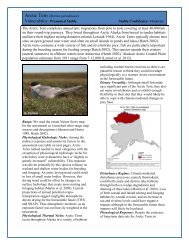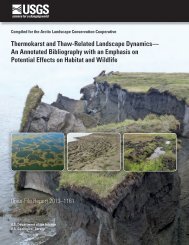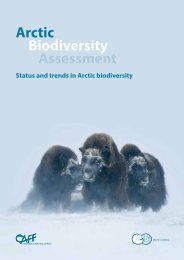Assessing Climate Change Vulnerability of Breeding Birds in Arctic ...
Assessing Climate Change Vulnerability of Breeding Birds in Arctic ...
Assessing Climate Change Vulnerability of Breeding Birds in Arctic ...
You also want an ePaper? Increase the reach of your titles
YUMPU automatically turns print PDFs into web optimized ePapers that Google loves.
egion s<strong>in</strong>ce they sometimes prey on theeggs and young <strong>of</strong> nest<strong>in</strong>g birds.The results also do not speak to theresponse <strong>of</strong> species to climate changeoutside <strong>of</strong> the <strong>Arctic</strong> LCC region <strong>of</strong> Alaska.The 54 species we considered <strong>in</strong> theassessment reflect a representative crosssection<strong>of</strong> species <strong>in</strong> the Alaskan <strong>Arctic</strong>;however, species that currently do not occur(or barely occur) with<strong>in</strong> the assessment areacould move <strong>in</strong>to the region and subsequentlyaffect other species. For example, CommonLoons could expand their range northwardfrom <strong>in</strong>terior Alaska and compete withYellow-billed Loons for resources.Similarly, some dabbl<strong>in</strong>g duck species thatare currently present but are more commonbreeders to the south (e.g. Mallard, NorthernShoveler) may <strong>in</strong>crease and compete withspecies occupy<strong>in</strong>g similar niches to thenorth.It is appropriate to <strong>in</strong>terpret ourassessment and other efforts to understandclimate change vulnerability <strong>in</strong> comb<strong>in</strong>ationwith exist<strong>in</strong>g conservation rank<strong>in</strong>gs (see alsoYoung et al. 2010), as climate change mayexacerbate stressors that are alreadyaffect<strong>in</strong>g many bird species (e.g., Gardali etal. 2012). Three <strong>of</strong> the four species currentlylisted under the US Endangered Species Actor recently considered for such list<strong>in</strong>g <strong>in</strong><strong>Arctic</strong> Alaska were ranked as vulnerable <strong>in</strong>our assessment (e.g., Steller’s Eider, BuffbreastedSandpiper, Yellow-billed Loon;Figure 4.1). Spectacled Eiders, another listedspecies, was near the vulnerability threshold.For these species, our results re<strong>in</strong>forceconsiderations for cont<strong>in</strong>ued protections. Atthe same time, our assessment might raiseconcerns about climate changevulnerabilities for species otherwiseconsidered stable with respect to the effects<strong>of</strong> non-climate stressors (e.g. Gyrfalcon,Common Eider).It may also be prudent to morethoroughly consider the key sources <strong>of</strong>sensitivity identified for species that arepresumed stable but near the moderatelyvulnerable threshold. While from a relativeperspective these species may not be <strong>of</strong>greatest concern, a s<strong>in</strong>gle key climaterelatedsensitivity has the potential to bedetrimental. It may be useful to focusresearch agendas and proactively developresponse strategies and monitor<strong>in</strong>g plansthat can be <strong>in</strong>tegrated <strong>in</strong>to relevantmanagement plans.Conservation and management activitiesIt should be acknowledged that tools forreduc<strong>in</strong>g climate change vulnerabilities maybe somewhat limited <strong>in</strong> <strong>Arctic</strong> Alaska. Theregion’s vast size and remoteness, and thesensitivity <strong>of</strong> its habitats to change, make itdifficult to contemplate actionscommensurate with the potential impacts(Zack and Liebezeit 2012). The results <strong>of</strong>this assessment enhance our understand<strong>in</strong>g<strong>of</strong> the potential responses <strong>of</strong> particularspecies to climate change and maycontribute to th<strong>in</strong>k<strong>in</strong>g about futureconservation actions and land protection <strong>in</strong>the context <strong>of</strong> energy and other developmentissues. Attempt<strong>in</strong>g to identify climaterefugia and enhanc<strong>in</strong>g the protection <strong>of</strong> largeunits <strong>of</strong> land may, at present, be the beststrategy for conserv<strong>in</strong>g species as climatedrives changes <strong>in</strong> the region. Our assessmentsuggests several species for which climate<strong>in</strong>ducedlandscape changes might reduce thequality or availability <strong>of</strong> suitable habitat <strong>in</strong>currently utilized locations.30








